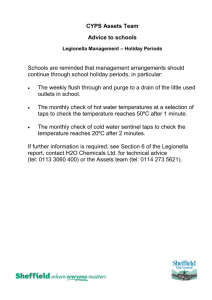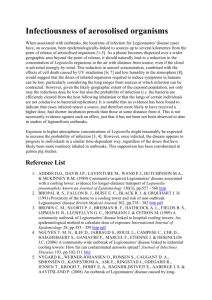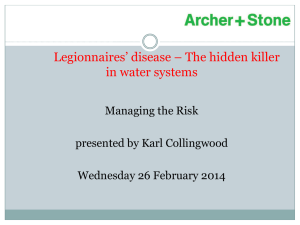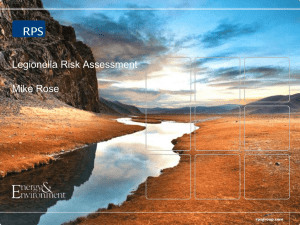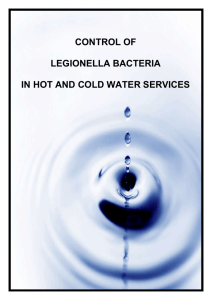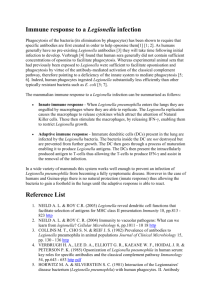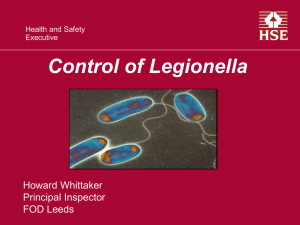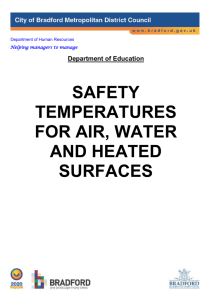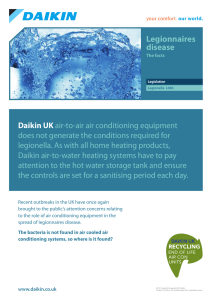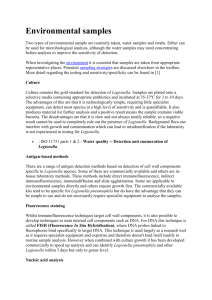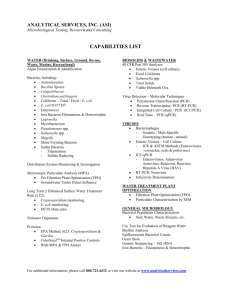CDM 2007 MAKING A DIFFERENCE
advertisement
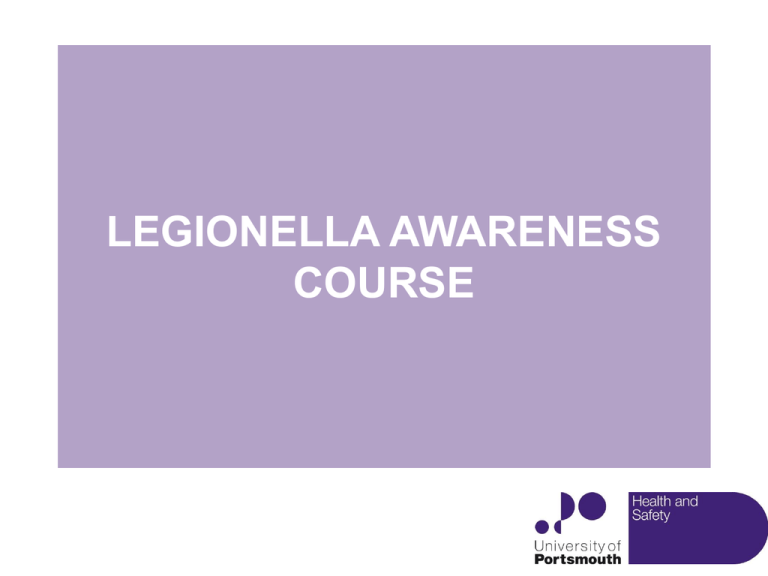
LEGIONELLA AWARENESS COURSE COURSE OBJECTIVES To enable you to be aware of issues associated with Legionella within the UoP & be able to assist in the delivery of the Management Plan. LEGIONELLOSIS • • • • • Legionella = water-borne bacteria Naturally widespread in the environment Over 50 different species identified 20 known to cause disease in man Legionella pneumophila – Legionnaire’s Disease • Pontiac Fever / Lochgoilhead Fever Legionella sp. under UV illumination Legionella pneumophila LEGIONELLA • • • • • Temperature range 20 - 50°C Proliferates at 37 °C Requires nutrients Slow moving / stagnant water Poorly managed water system = perfect environment SYMPTOMS • • • • • • • Head & muscle ache Tightness in chest Dry cough Sickness & diarrhoea Confusion / delirium Coma Death ‘AT RISK’ GROUPS England & Wales Cases 250 200 150 Cases Male Female 100 50 0 0-9 10-19 20-29 30-39 40-49 50-59 60-69 70+ Age in Years CHAIN OF EVENTS Bacteria present in water system Slow moving / stagnant water Adequate food source Temperature range 20-50°C Aerosol formed People present RISK AREAS • • • • • • • • Hot & Cold Water Systems Cooling Towers & Air Conditioning Storage Cisterns Calorifiers Deadlegs Showers Spa pools LEV’s/ Fume Cupboards Showers Operate at desired temps Poor hygiene Infrequently used Prone to scaling Create aerosol Showers Any Questions ? Hot and cold water systems Cause the most cases Cold Water Storage Tanks Dirty Tanks = clean & disinfection Types of Water Heaters Legionella Control Regulation & Legislation Legislation • Health & Safety at Work etc Act 1974 (HSAWA) • Management of Health & Safety at Work Regulations 1999 (MHSWR) • Control of Substances Hazardous to Health Regulations 2002 (COSHH) • The Notification of Cooling Towers and Evaporative Condensers 1992 • The Control of Legionella Bacteria in Water Systems Approved Code of Practice & Guidance 2001 ACoP L8 • Reporting of Injuries, Diseases and Dangerous Occurrences Regulations 1995 (RIDDOR) Approved Code of Practice • Identification and assessment of risk • Prepare a scheme for preventing or controlling the risk • Implement, manage and monitor precautions • Keep records • Appoint a person to be managerially responsible Risk Assessment & Control Measures Why does it matter ? The HSE views Legionnaires’ Disease as preventable • To satisfy regulation and legislation • To show due diligence • To protect employees and public When Should It Be Repeated? • At least every 2 years or when NO longer valid e.g. – Changes to the use of the building. – Availability of new information. – Control measures are no longer effective. – Case of LD associated with system. – Changes to the system or its use. Typical Written Scheme: H & C Water Systems Checks • • • • Monthly – temperature checks Quarterly - shower cleaning Six monthly - CWS Tank temperatures Annually - CWS Tank inspections, calorifier checks • Other systems as required • Weekly - flushing little used outlets Management & Training • Inadequate management, lack of training and poor communication have all been identified as contributory factors in outbreaks of Legionnaires Disease. • Those who are appointed to carry out control measures and strategies should be suitably informed, instructed, properly trained and their competency assessed. Appropriate Records • Responsible persons • Significant findings of the risk assessment • Written scheme of actions and control measures • Results of any monitoring, inspection, test or check carried out Typical Log Book Records • • • • • • Training records Lines of communication Current state of operation Signature of person that did the work Plans or schematic drawings Visit log for engineers/contractors Schematics Example O LD S D IE CW ST 1 SECOND F LOOR ROOM 2 FR I ST F LOOR ROOM 1 CW ST 2 ROOM 3 ROOM 8 GROUND F LOOR CW ST 3 ROOM 4 ROOM 9 ROOM 1 4 TO ROOM 1 0 DS I AB LED TO ILET CW ST 6 ROOM 1 7 ROOM 1 1 LAD E IS TO ILE T ROOM 1 8 ROOM 1 2 MAN I KT I CHEN ROOM 2 0 ROOM 5 KT I CHEN S TAF F GENTS ROOM 2 1 S TA F F BATHROOM ROOM 6 KT I CHEN S TAF F LAD E IS CW ST 5 ROOM 2 2 ROOM 2 3 ROOM 2 4 ROOM 7 OUTS D IE KEY :fol w o m f a ni s w a et r CA L 8 fol w o fc o dl w a et r CA L 7 fol w o fh o tw a et r MAN I SW ATER T TI LE EXAM P LE H O TE L W A TER SC H EM A T CI , AS SEEN kc D A TE O : C T 2003 R EF A : BC H O TE L H 2O C H EM CI A LS L TD Why keep Records? • To demonstrate compliance with the law • Show what control measures are being taken • Monitor water temperatures, system cleanliness, bacteria levels (if appropriate) • Show trend analysis learn more about the systems • Review performance • Provide evidence of reducing the risk Any Questions ?
